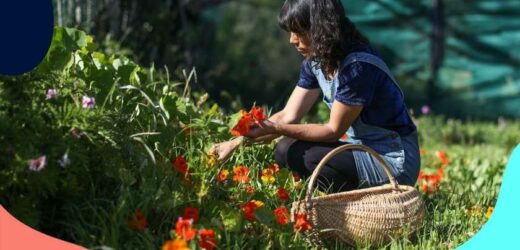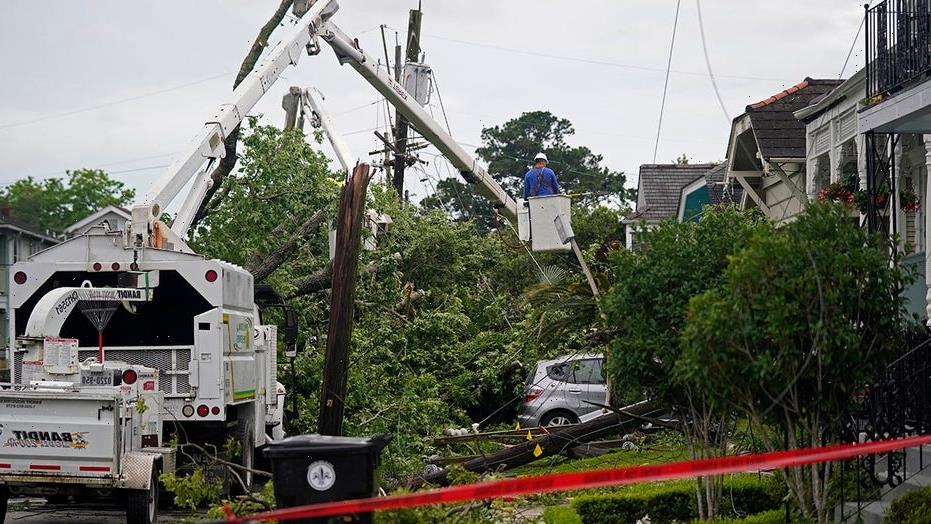If you look at nature hard enough you’ll find all sorts of exciting things to eat in it. Here’s your ultimate guide on foraging safely wherever you are in the UK and how to make the most of your wild harvest.
Welcome to The Curiosity Academy, Stylist’s new learning hub where you can access workshops, how-to guides, new research and learn the most up-to-date skills from the UK’s most in-the-know people.
Not only is nature a balm in anxious times – spending just 10 minutes surrounded by the natural world can reduce our stress levels –it’s also teeming with edible plants you can just pick up, eat, cook or brew in a tea without an ounce of supermarket plastic in sight.
Foraging (aka identifying and harvesting wild foods) has boomed over the last year. Thanks to our renewed love for the natural world during the pandemic, social media interest in foraging grew by 89% over the year, according to the annual Waitrose Food and Drink report.
“Foraging was my saviour in lockdown,” says Leah Apostolou, a foraging walk leader at forest school EcoWild. “It helps you slow down and tune in. It’s a very mindful, peaceful activity.” Over the pandemic she noticed the foraging movement grow as people felt more connected to nature. “It’s great that people are remembering how important our environment is to us,” says Leah. “There is so much abundance around us, that people just didn’t realise.”
The phrase ‘ethnobotany’ is important in foraging, describing how plants have a whole host of different uses. “When humans use plants in foraging, the main thing we look for is what we can eat, but plants can be really useful for other things like making rope or dyes,” says Leah. “The more aware we become of how we can use resources that are readily available, the more we’ll care about the land around us, which is really important at the moment with the climate crisis.”
You may also like
Creating a garden without any green space: how to turn your balcony or patio into an urban jungle
Leah’s love for foraging began when she was growing up surrounded by beautiful countryside in North Wales. “You start taking notice of what’s around you,” she says. “I started taking pictures of plants. I’d go home and research them, then I started buying myself books. It gets quite addictive.”
Professional foragers have usually consolidated years of research and reading to be able to go out and confidently pick food. But that doesn’t mean beginners should feel intimated. Wherever you live in the UK, there will be foods you can forage just a stone’s throw from your doorstep and make into meals, drinks and even skin balm.
Here is Leah’s expert foraging guide delving into all the things you’ll need to know if you’re heading out to collect food, from the rules and regulations around picking and safety guidelines you’ll need to know, to which seasonal plants to look out for and, most importantly, delicious recipes you can eat them in.
Leah’s advice for new foragers
Be safe
“The number one rule is: if in doubt, leave it out,” says Leah. The UK is home to some very deadly plants and mushrooms so you should always be completely sure you can identify what you’re picking.
“There are lots of lookalike plants,” says Leah. “So even if you think you know exactly what you’ve picked it’s always good to double-check.”
Leah advises getting to know what the most poisonous plants and mushrooms are first so you can avoid them. Books are the most reliable way to learn because they are peer-reviewed. Leah recommends The Forager’s Calendar: A Seasonal Guide to Nature’s Wild Harvests by John Wright and Wild Food UK’s Foraging Pocket Guide. The River Cottage Handbook is a good place to start if you’re interested in mushrooms.
Going on a walk with a professional guide is also a good way to get a comprehensive rundown of what you can pick. Online resources can be helpful. But Leah warns against relying on forums or apps because it’s difficult to determine who is a trustworthy professional.
Mindful picking is also important. “Take your time, make sure you know exactly what you’re picking, and try not to be clumsy with it,” says Leah. “It’s easy to get excited and grab huge handfuls, but in that handful, you may have accidentally picked up another plant which could be poisonous.”
Be responsible
Remember plants, trees and fungi are really important for our ecosystem. Animals and insects rely on them to live. “So, don’t be greedy,” says Leah.
Make sure there’s plenty of the plant you want to pick and only take a small percentage. Spread out your picking and don’t take all the leaves from one plant because that will hinder its growth.
Know the rules
It’s OK to pick in public places and on byways, however, uprooting plants isn’t allowed because it removes them from the ecosystem.
Avoid foraging in Sites of Special Scientific Interest (SSSI) or anywhere that’s a site of conservation. If you want to pick on private land, you must get permission from the landowner first, “generally people don’t mind,” says Leah.
Furthermore, you can only forage for personal consumption. Doing it for financial gain is illegal.
Leah’s favourite foraging plants for beginners
Nettles
Nettles are an amazing foraging super food “People completely disregard nettles, but they’re actually an amazing superfood. They’ve got vitamins A, C, K, B6 and contain a lot of protein gram for gram. They really pack a punch compared to spinach. They grow everywhere, you just need to watch out for the stings. Wear a pair of gloves or pick them from lowdown and pull upwards with their hairs.”
How to eat it:
“Nettles are really versatile. You can use nettles in the same way you’d use spinach. The seeds are amazing too.”Dead nettles
Dead nettles: you can eat the plant raw in salads. “Dead nettles look very similar to normal nettles, but they don’t sting. You can identify them from their square stem and white flowers. There are different types: the red dead nettle has purple leaves and purple flowers. You can find it in the same place as nettles, in verges or in fields.”
How to eat it:
“It’s delicious. You can eat it raw, it’s really great in salads.”Wild garlic
Wild garlic: the pungent plant grows in huge clumps. “Wild garlic likes damp, shaded areas often in ancient woodlands. It grows in big patches and usually appears in March. Its flowers last from May to June. It has long, smooth bright green leaves and delicate clusters of white flowers. It’s super good for you, too. Wild garlic has more medicinal benefits than shop-bought garlic. It’s very nutritious.”
How to eat it:
“You can blend or chop the leaves and use them as you would regular garlic. You can also eat the flowers. Once the flowers have dropped you get little seed buds. The seeds look like green peppercorns, they’re really fiery and super garlicky. You can pickle them and use them throughout the year. Or, cook with them.”Garlic mustard
Garlic mustard: the white-flowered plant makes nice salsa verde “Garlic mustard, or Jack-by-the-hedge is it’s other name, is good to pick in spring and summer. You’ll see it all over the place in verges. It’s got beautifully scalloped edges and white flowers. It tastes milder than wild garlic and ever so slightly of mustard.”
How to eat it:
“It’s great to use in salads. Or, you can use it to make a nice salsa verde.”Dandelions
Dandilion: dandilion tea is good for your urinary system. “People consider dandelions as weeds and we walk past them all the time, but it is edible. You can eat the leaves when they’re young, fresh and green. When they get older, they get a bit bitter, so the fresher and greener, the better.”
How to eat it:
“You can add the leaves to salads. You can also dig up the roots, if you’ve got permission from a landowner, dry them out and use them as a coffee alternative. Dandelions are a mild diuretic, they’re super good for your urinary system. People make dandelion tea. It’s a really good cleansing herb for the liver and kidneys. You can sprinkle the petals over a salad, or make them into a lovely thick syrup, often called dandelion honey, if you heat the flowers up with water and sugar.”
Beech
Beech: tree leaves are very good raw in spring and early summer “The leaves of trees are very good in spring and early summer. One of my favourites is beech leaves. Really young beech leaves are bright, fresh lime green and ever so slightly translucent. You can pick them and eat them off the tree. They’ve got like a real zesty, appley flavour.
How to eat it:
“It’s brilliant in a salad. Or, people love to make a Japanese drink called a beech noyau, where the leaves are steeped in gin. You’ll find that people who forage like to make alcohol, tea, or salad. This is a particularly good alcohol recipe. You can steep the leaves in the gin for two or three weeks, then fish them out and add some sugar and brandy. It’s really delicious.”Sorrel
Sorrel: the edible plant has an apple-peel taste. “I really love sorrel, it’s one of my favourite things to forage. It’s really zesty and tastes like apple peel. It’s got long, arrow shaped leaves and grows in fields and lawns.”
How to eat it:
“It is really delicious in salads.”Ribwort plantain
Ribwart plantain: the weed has medicinal properties. “If you’re foraging in the city look for things growing through the cracks of pavements like ribwort plantain. It’s easy to identify because it’s got really prominent veins like ribs on the back of its leaf.”
How to eat it:
“You can make a nice tea out of it. But, more than that, it’s good for its medicinal properties. You can make a really good soothing skin balm with it.”Images: Getty
Leah Apostolou, foraging walk leader and bushcraft practitioner
Leah Apostolou, foraging walk leader and bushcraft practitioner Leah is a bushcraft practitioner with a background in youth work and adventure sports. She leads foraging walks with forest school EcoWild and posts foraging tips on her Instagram page @leah.lou.foraging. She is a strong advocate for using nature as therapy.
Source: Read Full Article


